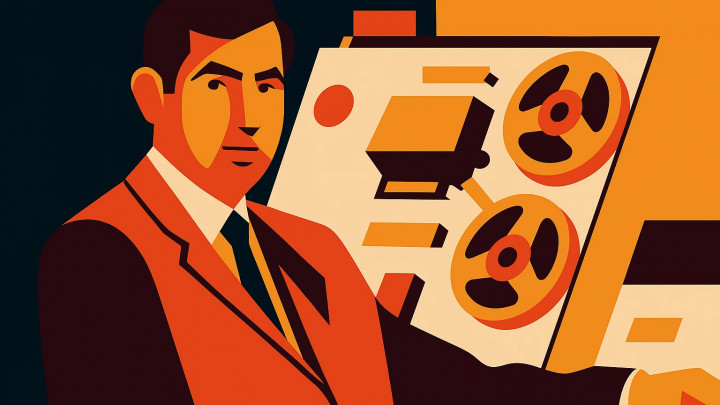The Science of Speaking: Why the Pimsleur Method Actually Works
Picture this: you’ve spent months studying a new language. You know the grammar rules, you’ve memorized flashcards, but when it’s time to actually say something… you freeze. Your mind goes blank. Sound familiar? You’re not alone. This is precisely the problem that Dr. Paul Pimsleur’s revolutionary method was designed to solve. Instead of forcing you to cram rules, Pimsleur flips language learning on its head, teaching you to speak the same way you learned your first language: through listening, repetition, and natural intuition. In this article, we’ll dive into the science behind the method, weigh its pros and cons, and show you how to supercharge its effectiveness with modern tools like Vocafy.

The Breakthrough Idea: The Origin of the Method
In the 1960s, linguistics professor Dr. Paul Pimsleur set out to understand why so many people fail at learning a new language. His groundbreaking insight was that traditional education often starts at the wrong end: it focuses on reading and complex grammar rules, while the most critical skill—speaking—is left behind. Dr. Pimsleur observed that children learn to communicate perfectly without ever hearing the term "past participle." His goal was to create a method that mirrored this natural, organic process, putting the focus squarely on listening comprehension and confident speech.
The Science Behind the Method: 4 Core Principles
The Pimsleur Method isn't just a good idea; it's built on a solid foundation of psychology and linguistics. Let's break down the four key principles that make it so effective.
1. Spaced Repetition System (SRS)
This is the heart of the method. Long before digital apps, Pimsleur applied the principle described by Hermann Ebbinghaus's "forgetting curve." The concept is simple: when you learn something, the memory fades over time. But if you recall that information just before you’re about to forget it, your brain locks it in much more strongly. Pimsleur lessons do this perfectly: a new word is introduced and then you’re prompted to recall it after a few seconds, then minutes, then hours, and eventually days. This scientifically-proven technique is one of the most efficient ways to move knowledge into your long-term memory.
2. The Principle of Anticipation
Ever zoned out while passively repeating phrases in a language lesson? Dr. Pimsleur knew this wasn't effective. His method forces you to be an active participant. During a lesson, the narrator will pose a challenge (e.g., "How do you say...?") and then pause. In that moment of silence, you have to actively search your memory for the answer. This process of anticipating the correct response transforms learning from passive listening into active problem-solving. It simulates a real conversation where you must construct your own sentences.
3. Core Vocabulary
Why learn thousands of obscure words when a few hundred can cover 80% of everyday conversation? Pimsleur built his method on this Pareto Principle (the 80/20 rule). The lessons intentionally focus on a limited but highly functional set of core vocabulary. You learn the words and phrases that are most essential for day-to-day communication. This prevents you from feeling overwhelmed and delivers quick wins, allowing you to have simple conversations after just a few lessons.
4. Organic, Context-Based Learning
Forget grammar charts. With Pimsleur, you don't memorize grammar; you acquire it. Phrases are always presented in full sentences and within the context of real-life situations (greetings, ordering food, asking for directions). Your brain naturally starts to recognize patterns and internalize grammatical structures, just as you learned the nuances of your native language as a child without ever opening a textbook.
Pros and Cons: Who is it Really For?
Advantages
✅ Rapidly Improves Speaking & Pronunciation: Since it’s all audio, you hear and practice correct pronunciation from day one, building speaking confidence quickly.
✅ Learn Anywhere, Anytime: All you need is a way to play audio and 30 minutes a day. It's perfect for commuting, doing chores, or working out.
✅ Builds Real Confidence: The quick success and constant speaking practice provide a major confidence boost, which is a powerful motivator in language learning.
Disadvantages
❌ Limited Vocabulary: The focus on core vocabulary means your lexicon will grow slowly. You won't be discussing complex topics like global politics.
❌ Reading & Writing Are Neglected: As a purely auditory method, it does not develop your reading or writing skills. This is a significant drawback for languages with non-Roman alphabets (e.g., Japanese, Russian).
❌ Can Be Costly: Official Pimsleur courses are often more expensive than many other language-learning resources.
In short, the Pimsleur method is ideal for you if:
- You are an absolute beginner looking to quickly reach a basic conversational level.
- You are a traveler who needs to learn survival phrases for a trip.
- You are an auditory learner who absorbs information best by listening.
- You have speaking anxiety and want a method that gently forces you to speak.
How to Maximize the Pimsleur Method? The Vocafy Supercharge!
Pimsleur provides a brilliant foundation, but what if you want to overcome its weaknesses? This is where Vocafy steps in, allowing you to perfectly complement and customize your learning journey.
- Fill the Vocabulary Gaps
Pimsleur teaches you how to order a coffee, but what if you want to talk about your hobbies or your job? Find articles, song lyrics, or dialogues online about topics that genuinely interest you. Paste the text into Vocafy, which transforms it into crystal-clear, native-quality audio. Create your own custom audio collections with the words and sentences that matter to you, and listen to them on repeat—just like a personal Pimsleur lesson! - Bridge the Listening-Reading Gap
Pimsleur's biggest limitation is its lack of written text. With Vocafy, you can build that bridge. As you listen to the audio generated from your own texts, follow along with the written words on the screen. This powerful combination develops your listening, pronunciation, and reading skills all at the same time. - Practice Actively, Pimsleur-Style
Use the Vocafy player creatively to mimic Pimsleur's active recall. Pause the audio after a sentence and try to repeat it aloud. Or, listen to a question, hit pause, and challenge yourself to form an answer before you continue. With this technique, you can turn Vocafy into your own personal, limitlessly customizable Pimsleur engine.
Final Thoughts
For over half a century, the Pimsleur method has proven that confident communication is the key to mastering a language. It offers an outstanding starting point for anyone who wants to learn to speak quickly and effectively. By itself, however, it isn't a complete solution.
But today's language learner has the power to get the best of both worlds. You can use Pimsleur's scientifically-backed principles to build a strong speaking foundation, and then enhance it with the flexibility and personalization of Vocafy. This approach makes learning not only more effective but also deeply personal and far more motivating. Are you ready to start speaking?





